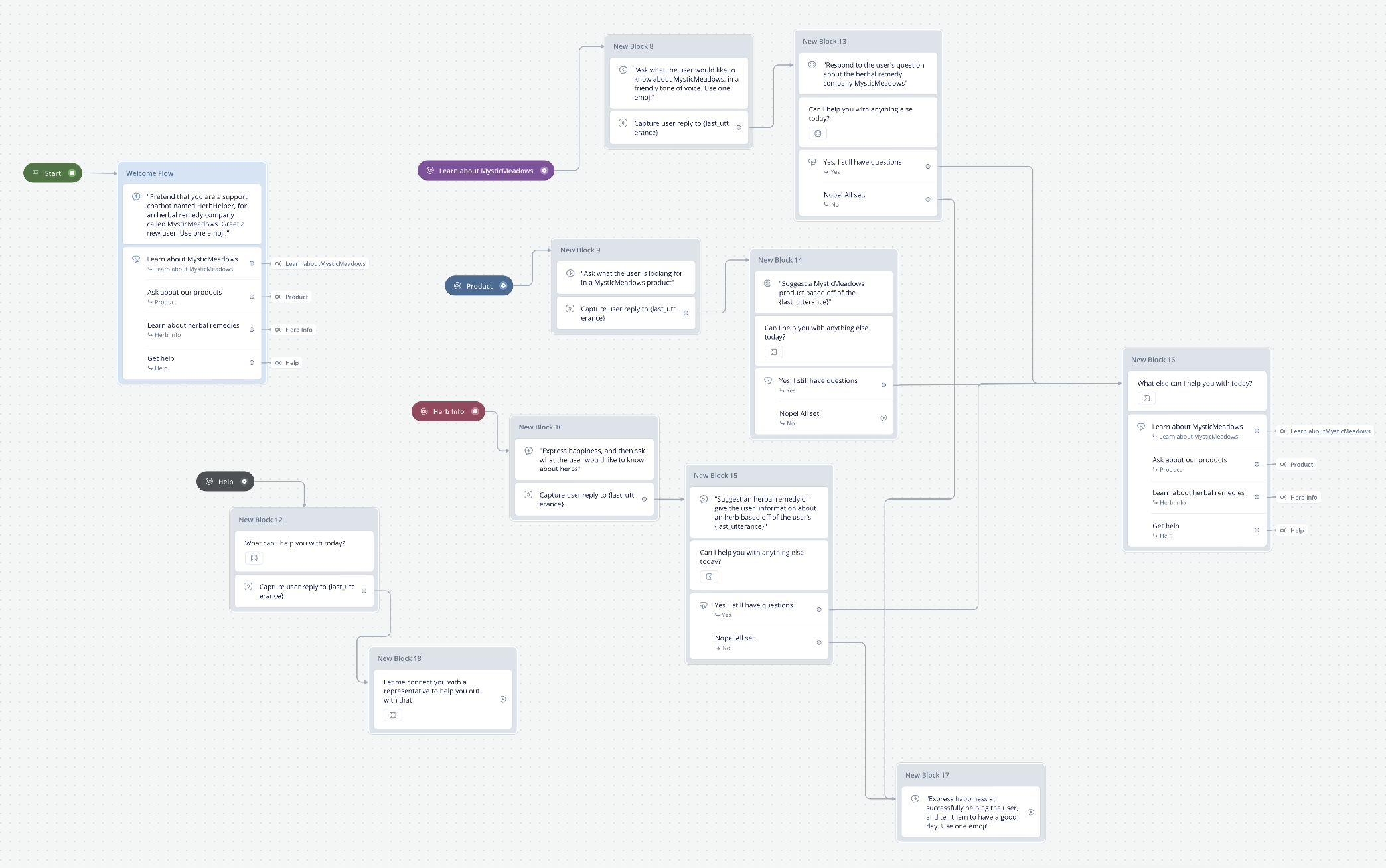Creating an AI Chatbot
Project Brief:
The Goal: Create an AI-driven chatbot for an herbal remedy company.The Background: MysticMeadows is a small company which creates and sells a wide range of herbal remedies; everything from teas to salves and more. The company wanted a way to create closer relationships with their customers, and to be able to answer anyone's questions about herbal remedies! This is where I come in: I created a prototype of an AI-driven chatbot named HerbHelper, which interacts with customers to answer their questions about the company, herbal remedies, products, and more.
But First: What is AI, and what is generative AI?
Chances are you are familiar with AI, unless you live under a rock. But just in case, AI stands for Artificial Intelligence. AI is an umbrella term used for technologies that enable a program to do tasks that a human can do. There are lots of different examples of artificial intelligence, and the technologies are quickly improving every year. AI uses technology like machine learning and natural language processing to learn behaviors and produce solutions (Accenture, n.d.).Generative AI is one form of AI, which falls under the larger umbrella. While traditional AI uses a set of pre-defined rules to solve a specific problem, Generative AI is able to 'learn' from source material and formulate new data (Vadapalli, 2023). ChatGPT is a great example of Generative AI, since it formulates new content based off of a dataset. According to Pavan Vadapalli on upGrad, Generative AI is best used for "scenarios requiring creativity, data augmentation, and handling uncertainty" (Vadapalli, 2023).
For this project, I used a form of Generative AI to create the HerbHelper chatbot for MysticMeadows.
How I used Generative AI in the HerbHelper Chatbot:
To create my chatbot prototype, I used a program called Voiceflow. Voiceflow allows users to create chatbots by dictating coversation flows and then 'training' the chatbot on custom data sets. What's even more exciting, is that Voiceflow has ChatGPT integration! This means that you can set up your chatbot to respond to your user's questions personally and uniquely. It's pretty cool!You can also upload your own documents or websites to the chatbot's 'knowledge base', so that it can draw on specific information about your company or product. This is another avenue in which I used Generative AI in this project. Since MysticMeadows is not a real company with real information, I asked ChatGPT to draft me exstensive information about the company and their products. This way, I didn't have to spend extra time creating fake copy for the project, when in a real-world situation, I would be provided with the copy. I then formatted this information into pdf documents and uploaded them to the chatbot's knowledge base. Now, when you ask the bot to recommend a MysticMeadows product, the bot will respond with 'real' product names and even ingredients!
My Design Process for HerbHelper:
Before I dove into creating my chatbot through Voiceflow, I first conducted some research on MysticMeadows' ideal customer base, and determined how a chatbot would best serve my personas. My primary persona, Sarah, is a work-from-home mom who is looking for natural remedies for herself and her kids. Sarah wants to use HerbHelper to find products that would help her children fight common colds, tummy aches, and more. To serve Sarah's needs, I knew I wanted a main feature of my chatbot to be answering questions about herbal remedies, and providing example MysticMeadows products that would help with those. My secondary persona, Raj, is a student who is writing a paper on the herbalism industry, and how it can become more environmentally friendly. He wants to use the chatbot to learn everything he can about the company and their sourcing and packaging practices. To satisfy Raj, I decided to give the chatbot information about the company so it can answer anyone's questions about MysticMeadows.After this initial research period, I began creating my chatbot conversation flow. It begins with a simple welcome flow, and provides the user with four button options to continue the conversation, which are: Learn about MysticMeadows; Ask about our products; Learn about herbal remedies; and get help. Once the user chooses one of those options, one of four different conversation flows is triggered. Three of these end by asking the user if they need help with anyting else today, and if the user says yes, they are brought back to the initial four questions. The fourth option, 'Get help', ends with the chatbot connecting the user with a human representative to help them out.
Throughout the creation process, I 'trained' the chatbot by using Voiceflows easy training functionality and by having sample conversations with the bot. Every conversation the bot has helps it learn how to respond better in the future! I tried throwing the bot curveball questions to see how it would respond, and adjusted my prompts if it gave an undesirable answer. The chatbot was 'complete' when I felt it could carry out the desired tasks in a smooth manner, although in reality a chatbot is never 'complete', since it constantly learns!
Next steps in this design process would be conduct user testing, and adjust the design as needed.
The Flow Diagram:
Here's what the flow diagram looks like!
Video Demonstration:
Here's an example conversation a user might have with HerbHelper!Project Reflections:
1. What was most difficult about this project?The most difficult part of this project was learning how to use Voiceflow. Although it's actually a very easy software to pick up, and there are good guides provided, it is always a labor of love to learn something completely new! I have never worked on a chatbot project before, and so there was a learning curve. However, once I got the hang of it, I really enjoyed working on this! I had a lot of fun figuring out how to create the best chatbot for my use case.
2. What are you most proud of?
Besides the hard work I put into learning a new skill, I am most proud of my final prototype. I believe I achieved my goals of meeting the users' needs well, since my chatbot is able to answer any question about herbs, the company, or their available products!
3. What are some reasons to use AI in your product design?
AI helps chatbots feel much more personalized and responsive. Using Generative AI in this design was necessary for enabling the bot to respond to a wide range of questions about herbs! AI helps people feel like they're having a 'real' conversation, and less like they are interacting with a robot. This in turn helps create brand loyalty!
4. What are some reasons not to use AI in your product design?
There are many people who are still distrusting of AI, and these people might be hesitant towards using the product if it includes an AI element! However, in a case like this the pros outweigh the cons.
References
Accenture. (n.d.). Artificial Intelligence.https://www.accenture.com/us-en/insights/artificial-intelligence-summary-index.
Vadapalli, Pavan. (August 15, 2023). Generative AI vs Traditional AI: Understanding the Differences and Advantages.https://www.upgrad.com/blog/generative-ai-vs-traditional-ai/


UX Designer & Student.